It is now the end of February and I have booked my flight to Sri Lanka for March 13. As a result, I will be in five states in two weeks – Punjab, Himachal Pradesh, Uttarakhand, Uttar Pradesh, and Madhga Pradesh, across the northwest of India. Kashmir and Ladakh are only accessible by air between October and late March and it is cold with lots of snow. Everyone who goes to either seems to have amazing experiences and I regret not going. Maybe another time. It will be a relatively rushed time with a lot of bus and train travel.
PUNJAB STATE
I took a 10 hour sleeper bus north across the border of Rajasthan into Punjab State (pop 30 million). Punjab translates into ‘Five Waters’ and is named after the five rivers of this fertile ‘rice bowl’ and ‘bread basket’. At partition in 1947, it was a tumultuous time. In 1966, Punjabi-speaking, primarily Sikh Punjab split from Hindi-speaking, primarily Hindu Haryana but they still share a capital, Chandigarh. Sikhism, founded in the 15th century, began as a reaction against the caste system and Brahmin domination of ritual. Sikhs believe in one god and although they reject the worship of idols, they focus on the pictures of the 10 gurus. Like Hindus and Buddhists, Sikhs believe in rebirth and karma, but there is no ascetic or monastic tradition ending the cycles of rebirth. There is a strict code of moral conduct abstaining from alcohol, tobacco and drugs, and engagement in a crusade for righteousness. Devout Sikhs do not shave their beard nor cut their hair and all have a steel bangle symbolizing fearlessness. Singh, literally ‘lion’, is the name adopted by many Sikhs. A belief in the equality of all beings lies at the heart of Sikhism. Its expressed by the practice of langar, where people of all walks of life sit side by side to share a complimentary meal prepared by volunteers in the communal kitchen of the gurdwara (Sikh temple). Sikhs only comprise 1.9% of India’s population.
I arrived in Amritsar (pop 1.25 million) in the early morning, got my hotel room, and prepared for a busy day. It is home to Sikhism’s holiest shrine, the spectacular Golden Temple. It is a wonderful site with the gold-plated gurdwara sitting in the middle of a large, square sacred pool connected by a causeway.
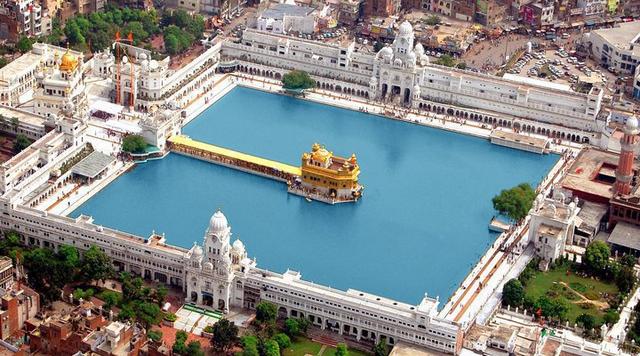
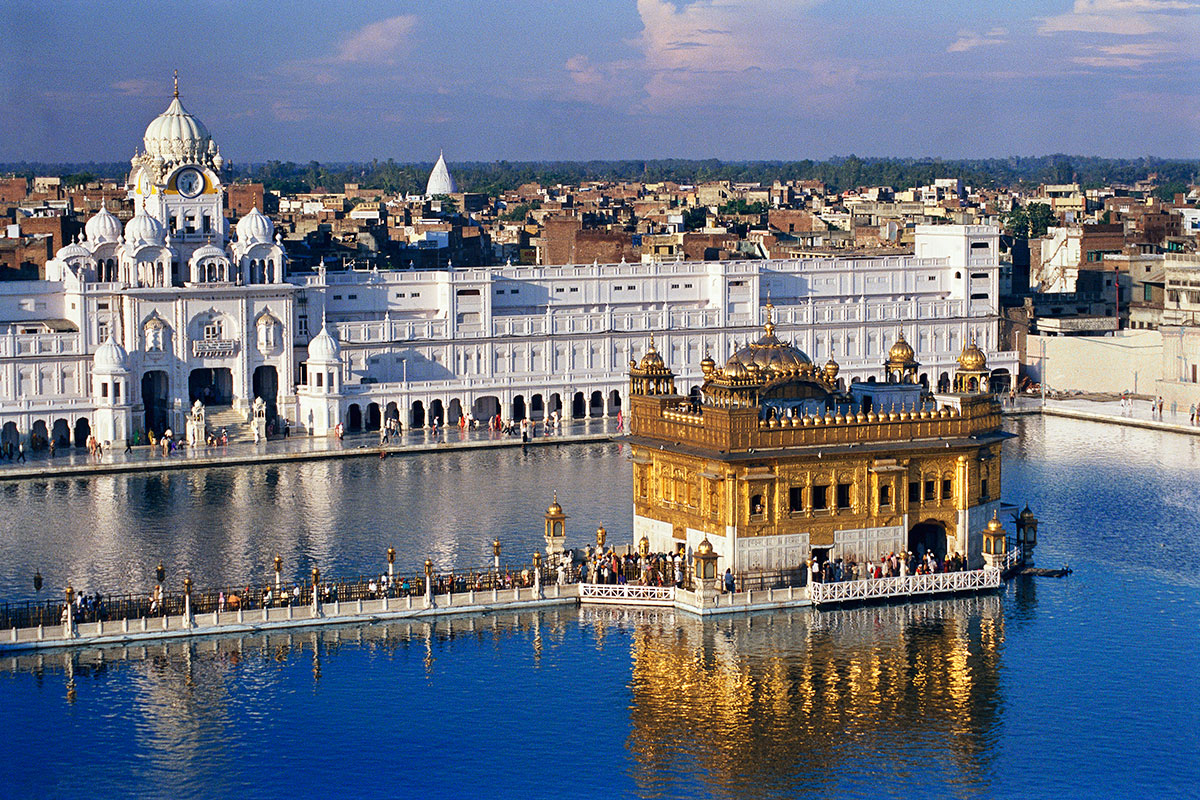

The golden dome is said to be gilded with 750 kg of gold and represents an inverted lotus flower, on top of a two-story marble temple. The lower parts of the marble walls are decorated with inlaid flower and animal motifs. Priests inside keep up a continuous chant from the Sikh holy book and this is broadcast around the temple complex. The inside is decorated in intricate gilded patterns.
Around the pool is a beautiful wide marble walkway with stairs leading into the pool and the occasional bather, surrounded in turn by white colonial style buildings and a clock tower. At one end is the Sikh parliament which was damaged when stormed by the Indian army in 1984. A nine story octagonal tower sits next to it. I ate in the huge free community dining room which prepares an estimated 60-80,000 meals per day. Everyone sits on the floor, it was over in 15 minutes and we were hurried out to make room for the next bunch. guy with a giant squeegee did a quick job on the spilled food.
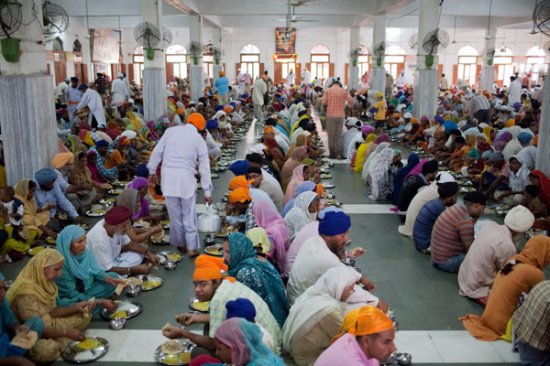
In the 1980’s, separatists seeking to create an independent Sikh homeland occupied the Golden Temple. The Indian army flushed them out in a controversial military action, fuelling violent Sikh-Hindu clashes leaving thousands (predominately Sikh) dead. There is a good museum detailing Sikh history in the building with the clock tower. To enter the complex, it is necessary to remove shoes and socks, wash your feet, and cover your head. It is a very holy, peaceful place.
Jallianwala Bagh, near the Golden Temple, is a park that commemorates the Indians killed or wounded by the British army in 1919. The controversial Rowat Act gave British authorities emergency powers to imprison without trial Indians suspected of sedition. 5000 Indians were holding a peaceful demonstration in the open space surrounded by high walls. 150 troops, without warning, opened fire killing some 400 and wounding 1500. 120 died when they jumped into a large well to escape the bullets. Some of the bullet holes are still visible on the memorial wall. It is a lovely green space with an eternal flame of remembrance, a large monument, and a Martyrs’ Gallery. The Mata Temple is easily the nicest Hindu temple I visited in all of India.

It commemorates the 20th century female saint Lal Devi. Women wishing to become pregnant come here to pray. The circuitous route to the main shrine passes through ankle-deep waterways, low tunnels, staircases, walkways and caves, the last of which turns out to be the inside of a cave-like divine mouth. The many walls are covered in fantastic murals made of mirrors and colored tiles. Dioramas and many statues represent several of the gods in the Hindu pantheon, all surrounded by the same wonderful mosaics.
That evening I went on a tour to the India-Pakistan Border at Attari-Wagah, 30 km west of Amritsar to see the late afternoon border-closing ceremony. Bags are not allowed, one is frisked at least twice and passports checked. There were at least 10,000 Indians on our side in huge bleachers, cheered on by a loud announcer, rousing music, and a male cheerleader. The Indian and Pakistan military meet at the border to engage in a 30-minute display of pure theatre. Dressed in turbans with a large red tops, a squad stomps out, mustaches twirled and eyes bulging. They parade up and down as dramatically as possible, preceded by a kick well over their head, in a high-octane pace with a full arm swing.
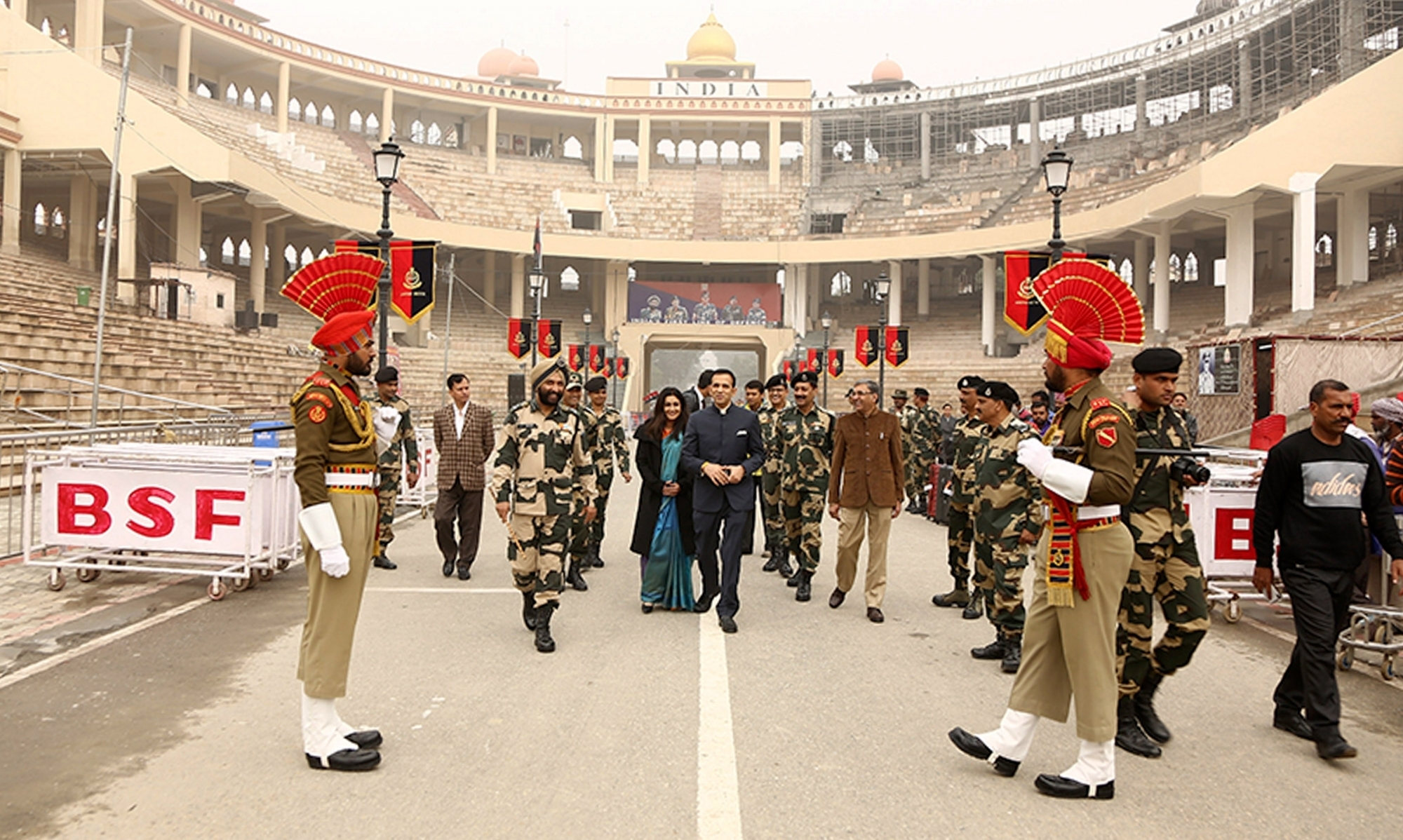
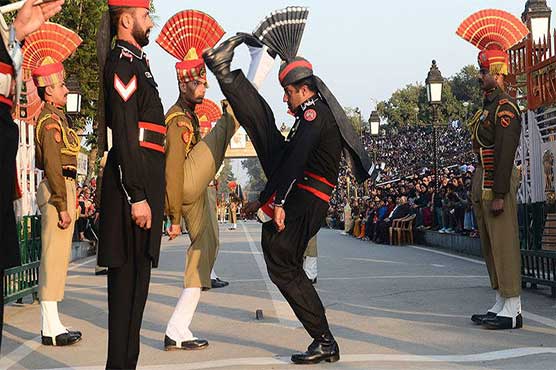
The gates are flung open and commanding officers shake hands, the flags are simultaneously lowered and the gates slammed shut. The same happens on the Pakistan side but there were considerably fewer Pakistanis in their bleachers. Meanwhile the crowd is going wild and chanting Long Live India in Hindi.
HIMACHAL PRADESH STATE
I then had a 7 hour day bus east into Himachal Pradesh State (pop 7 million). Crossing flat plains, we eventually climbed up onto a big plain with dramatic views of the Himalayas, to Dharamsala (elev. 1219 m), a grubby market town, and then a taxi 10km uphill to McLeod Ganj (elev 1707 m). This is the headquarter of the Tibetan government in exile and the residence of His Holiness the 14th Dalai Lama. It is a major backpacker destination with many budget hotels and restaurants. With a large Tibetan population (most refugees), many maroon robed monks roam the streets. They seem to have a worldly life – have smart phones, use iPods, ride taxis when they can walk, and eat in restaurants. The town was a backwater until 1960 when the Dalai Lama claimed asylum here following the 1951 Chinese invasion of Tibet. The Tsuglagkhang Complex is the main focus of pilgrims, monks and tourists. The temple is the exiles’ equivalent of the Jokhang Temple in Lhasa. Covered in murals and gilded statues, there were offerings of biscuits, cookies and fish sauce. The two temples are surrounded by the gompa where one can watch monks debate. Points of argument are sealed with a foot stomp and theatrical clap of the hands. Just inside the entry gate is the Tibet Museum telling the story of the Chinese occupation and the subsequent Tibetan exodus. The town also has many Tibetan government and cultural buildings. The Chinese take over of Tibet is one of the greatest travesties of our time as the Tibetan culture is being systematically destroyed and replaced with Han Chinese. About 25,000 Tibetans risk the clandestine, dangerous crossing each year usually through Nepal, and many come to the Dharamsala area. About 130,000 have fled and about 80,000 live in the area. I talked to a young fellow who had arrived in 2009, relating all the details of his escape which required bribing Chinese border guards. I had a nice time here hanging out with a lovely young Portuguese woman now living in France.
After another gruelling 10 hour overnight bus ride on government buses (a guy had a gigantic red suitcase in the aisle next to me, the bus was full, and it was not a comfortable sleep), I arrived in Manali (pop 4400/elevation 2050m), the adventure capital of India. With white water rafting, paragliding, and skiing (a downhill ski hill is close by) available, trekking is the main activity. However it is very limited during the winter with only a few day trips possible now. It is the main jumping point for Ladakh, Spiti and Lahaul but the road was closed to the end of March and these places are really only good places to travel from June to October. The landscape around Manali could easily be transplanted into the West Kootenay of southern BC, but there are no lakes and the lower slopes are all deforested. There are super views of the Dhauladhar and Pir Panjal Ranges and the fast flowing Reas River runs through the town. Most travellers stay in nearby Old Manali and Vashisht, but all the hotels and restaurants there were closed for the winter as most owners apparently head to Goa at this time of the year. I walked up to Old Manali and closer to town uphill to the Hindu Hadimba Temple. Erected in 1553, this ancient wood and stone mandir has wood carvings of dancers and horns of ibex and bulls adorning the walls. Stone feet under a massive low rock were the worshiped ‘idol’. Outside the temple, women with gorgeous white angora rabbits offered pictures for 40 cents or a purchase of the entire rabbit for $30. One could also get yak rides. A troop of macaque monkeys were eating garbage from a dumpster. Around town and the temple were forests of gigantic deodars (cedar) trees that resembled our Douglas fir. The electricity must have gone out every 15 minutes in town. Without much to do I left on the 3 PM bus after only 8 hours in town.
ULTARAKHAND STATE
This trip was a 15 hour marathon mostly over atrocious roads. The road went through a 3km long tunnel, entered a very steep walled valley and eventually hit the plains again. Driving too fast over bumps caused one to be lifted off the seat several inches all night long. The bus was luckily relatively empty and I thought I would have the opportunity to stretch out but I don’t think I slept a wink all night. When we hit a smooth stretch, I started clapping but not one of the 22 Indians on board even looked around. These last 3 bus rides have all been on government buses which are old and scruffy with bench seats like our school buses. They are cheap however (this last 15 hour ride cost about $10) and were all that was available on these last 3 routes. Except the first from Amritsar to McLeod Ganj which had many westerners, I was the only foreigner.
Exhausted, I arrived in Haridwar (pop 230,000, elev 240m), one of the holiest cities in India where the Ganges enters the plains from the Himalayas. It is the site of the recent Kumbh Mela, held every 12 years when tens of millions Hindus make a pilgrimage here (36 died in a train station stampede this year). The Ganges braids into 3 separate channels in the city creating great opportunities for ghats. It was then a 1 hour bus ride up to Rishikesh (pop 80,000, elev. 356m). Ever since the Beatles with their wives came to the ashram of the Maharishi Mahesh Yogi in the late 60’s, it has been a magnet for spiritual seekers and is now the self-proclaimed ‘Yoga Capital of the World’, with masses of ashrams and all kinds of yoga and meditation classes. Ringo Starr left after a few weeks (they did not like the food and missed their children) but the rest stayed for over a month. They relaxed and wrote tons of songs most of which appeared on the White Album. The Maharishi demands for money and his behaviour towards women eventually disillusioned all of them. A famous 1 week yoga festival was in progress in Rishikesh (cost about $500 including accommodation, food and classes). The fast flowing Ganges passes through town surrounded by high forested hills. It is a major backpacker hangout and gateway to treks in the Himalayas. I spent 3 days catching up on my sleep, reading, and writing on this website. I have been reading Being Indian, a book that I wished I had read at the beginning of my trip in India. It is a wonderful explanation of Indian behaviour that will greatly enhance your experience in India and a must read.
One afternoon I went out for a walk to see the sites of Rishikesh. The Shri Trayanbakshwar Hindu temple is first seen across the Lakshman Jhula hanging bridge. It is a huge 13 storey wedding cake with dozens of shrines to Hindu deities on each level interspersed with jewellery and textile shops. The nearby Swarg Niwas Temple has been converted into a yoga center. Shops, markets, restaurants, guest houses, and ashrams sprawl on both sides of the river forming the busiest part of upper Rishikesh. I then walked about 3 kms along the river to the Maharishi Mahesh Yogi Ashram, made famous by the Beatles. It was abandoned in 1997 and is now under the control of the forest department. The shells of many buildings, small, stone beehive meditation cells and lecture halls remain slowly being consumed by the forest undergrowth. I returned back along the river to a crowded area of temples, ashrams, sadhus, bathing ghats, and a crowded bazaar to the Parmarth Niketan Ashram Temple where every evening at sunset, the ganga aarti (river prayer ceremony) is performed. Several dignitaries were presented, there was nice singing, a chant and the aarti with candelabras and plates of candles. I have been staying in a lovely little hotel on High Bank where there are a group of 7 hotels popular with backpackers. For about #3.50, I have a small, spotless room with an en suite bath with a hot shower. It seems like every hotel is adding a restaurant or major addition. Three donkeys carrying sand and gravel to make the cement pass me every morning.
Ayurveda medicine, astrology, palmistry, and all sorts of alternative lifestyle ‘arts’ are all over India (every town has a Ayurvedic pharmacy), but biggest at Rishikesh. Ayurveda means ‘life knowledge’. 2000 years old, it seeks to balance the three humours, which becomes disordered in disease. Balance is restored by both or either of internal purification (removing built-up endotoxin in an intense detox regime of therapeutic vomiting, purgation, enemas, elimination of toxins through the nose, and detoxification of the blood), and herbal message (aromatic oil messages and herbal steam baths). Likewise astrology is big in India and is used to predict the most auspicious date for weddings and the best time and place to invest your money. Seems like it is all hogwash to me (trained as an allopathic physician gives me some bias however).
Hostels with dorm rooms are virtually never seen in India. Hotels costing from less than $2 to $30 have formed my price range. Most have been less than $15 but the quality is not often relative to the price. Places with large concentrations of backpackers have the lowest prices because of competition and cities which only see Indian tourists have by far the highest hotel rates (Indian tourists tend to be relatively wealthy and spend much more than we do). Air conditioning almost doubles the cost of a room and has not really been necessary this trip. Reservations are not always necessary but I think wise most of the time. It is an easy phone call that rarely costs more than 5 cents and one saves a lot of wandering around to find a room. Cleanliness is not what we can expect from motels and hotels at home – it is unbelievable how dirty the light switches are. Rooms less than $15 rarely come with a top sheet. A synthetic blanket is supplied, but I never use these (how can they be clean?), and instead I use a sleep sheet with my sleeping bag that zips out of make a perfect comforter. The bathrooms usually have a western sit down toilet and rarely a squat toilet. Some of these sit down toilets have wide wings so that standing on them and squatting is still possible – I guess when you are in the habit of squatting, western toilets seem strange – go figure. Showers are wet with no shower curtain and a drain often remote from the shower. Hot water is variable but one never sees the shower head heater so common in Latin America. You usually have to ask for a towel, and toilet paper and soap are not often provided.
I suppose that as Indians are not traveling this time of the year, I was able to book the rest of my travel in India by train, all in sleeper class which is very cheap. Up at 4:30, I took a taxi down to Hardiwar to catch the 6 AM train to Agra. At 5 the streets were a mass of people with thousands marching. Mostly young men, they were carrying on their shoulders semicircular frames with baskets on each end and flowers and tinsel decorating the frames. Traffic jams were created.
UTTAR PRADESH STATE
It was then a 10 1/2 hour ride on a busy train with constant aisle traffic from beggars to food sellers, through dense fog, to Agra (pop. 1.4 million), the location of the Taj Mahal. I’m glad this was not my first destination in India as it is a typical big dirty Indian city but with the most aggressive touts seen yet. Every shop, auto rickshaw, restaurant, or souvenir shop hits on you to use their services. It gets very tiring because they are so persistent. My tact has become to not even acknowledge their pleas for business – I used to politely say “no thank you” but that only seems to make them want to ask again and again. Paying no attention at all surprises them (I guess most people are more polite than me) and they rarely persist. There are more mosquitoes here than anywhere else in India.
The Taj Mahal is closed on Fridays so I decided to see some of the sites outside of town. Fatehpur Sikri (pop 30,000) is a magnificent fortified ancient city 40 km west and I caught the local bus
 .
.
The Mugal emperor Akbar founded his capital city here in 1571 but it was abandoned shortly after his death because of water shortages. He built the Jama Masjid, a beautiful immense mosque, still in use today. The main entrance is up a big staircase through the spectacular 54 m high Victory Gate, the tallest gate in Asia. Under the arched entry, huge natural beehives hung from the roof in curling masses of wax.
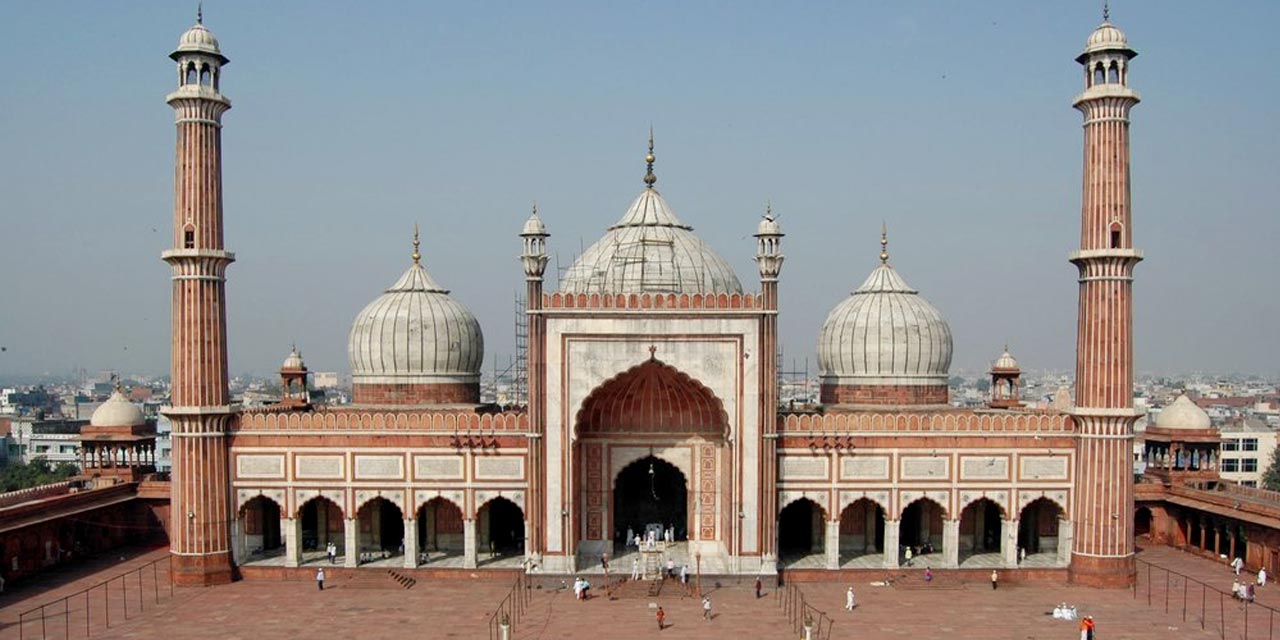

In the massive courtyard is the stunning white marble Tomb of Shaikh Salim Chishti entered through ebony doors. Inside are brightly coloured flower murals while the canopy over his grave is inlaid mother of pearl. The jali screens carved from one solid piece of marble are the finest in India. Women today desiring a son tie threads to the jali.

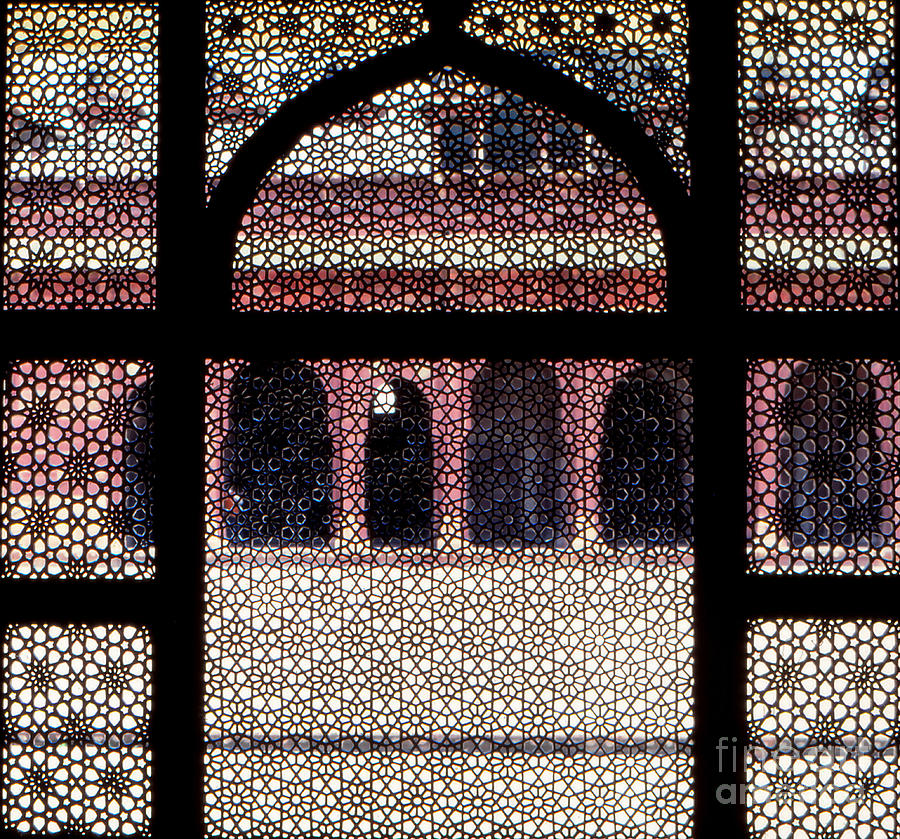
Behind the mosque is the entrance to a tunnel, apparently 40 km long that ends in Agra.
There is a great mosque with Indian, Muslim and Christian elements on the west side. On the east wall of the courtyard is the Kings Gate that leads to the palace complex, declared a Unesco World Heritage Site. It has a palace for each of his wives (one a Hindu, one a Muslim, and one a Christian). The palace to his Hindu wife, said to be his favourite, is set around an enormous courtyard, and has traditional Hindu columns, Islamic cupolas, and turquoise blue Persian roof tiles. Next to the kitchens is the smaller Palace of the Christian Wife with still visible painted ceilings. Outside a pretty ornamental pool has 4 bridges leading to a central platform in the middle for music and dance performers that he could view from his private quarters, the Abode of Fortunes. Behind this is his sleeping area, the Dream House with an immense elevated bunk bed. Heading north is the tiny Palace for his Turkish Islamic wife, with some of the most intricate carving I have ever seen in an Islamic building (better than La Hambra in Grenada, Spain). The Hall of Public Audiences, now a garden, was where Akbar carried out public executions with elephants trampling to death convicted criminals. The interior of the Hall of Public Audiences is dominated by a magnificently carved stone central column linked to the four corners by stone bridges. Next is a Treasury and a Astrologers Kiosk with roof supports carved in a Jain style.
The impressive Panch Mahal has five stories that decrease in size until the top is only a tiny kiosk. The ground floor has 84 columns, all different.


Bhibal Bhavan, a residence, is very ornately carved red sandstone. Ruins surround the complex and there are many more things to see. This was a great place, as you can tell by all the detail I included.
After arriving back in Agra, I took the bus 90 minutes to Mathura (pop 330,000), where Krishna, the 7th reincarnation of Vishnu, was born 3500 years ago. It is one of the seven sacred cities in India and attracts tons of pilgrims. Dotted with temples, I came to see the Kesava Deo Temple, where Krishna was born on a slab of rock in a small bare room. Getting in required a 20 minute line and two frisks. Soldiers with rifles were everywhere. 10 km north is Vrindavan (pop 60,000) where Krishna grew up. Hindu pilgrims come from all over India, and in the case of the Hare Krishna community, from all over the world. the International Society of Krishna Consciousness is based at the Krishna Balaram temple complex, accessed through a beautiful marble gate. It houses the tomb of Swami Prabhupada (1896-1997), the founder of the Hare Krishnas. There was a big group, mostly foreigners playing and singing in the temple. I also visited the 10 story Pagal Baba Temple, a fairytale-castle lookalike. It has a kitschy succession of animated puppets and dioramas that depict scenes from the lives of Ram and Krishna.

These are two big sightseeing days, and my second day was to see the Taj Mahal, one of the Seven Wonders of the World, and the top attraction in India. Some consider it the most beautiful building in the world. Over 3 million tourists, mostly Indian, visit every year. Even though I was there shortly after 6 AM, there was a 15 minute line for tickets and a 30 minute line at the East Gate.
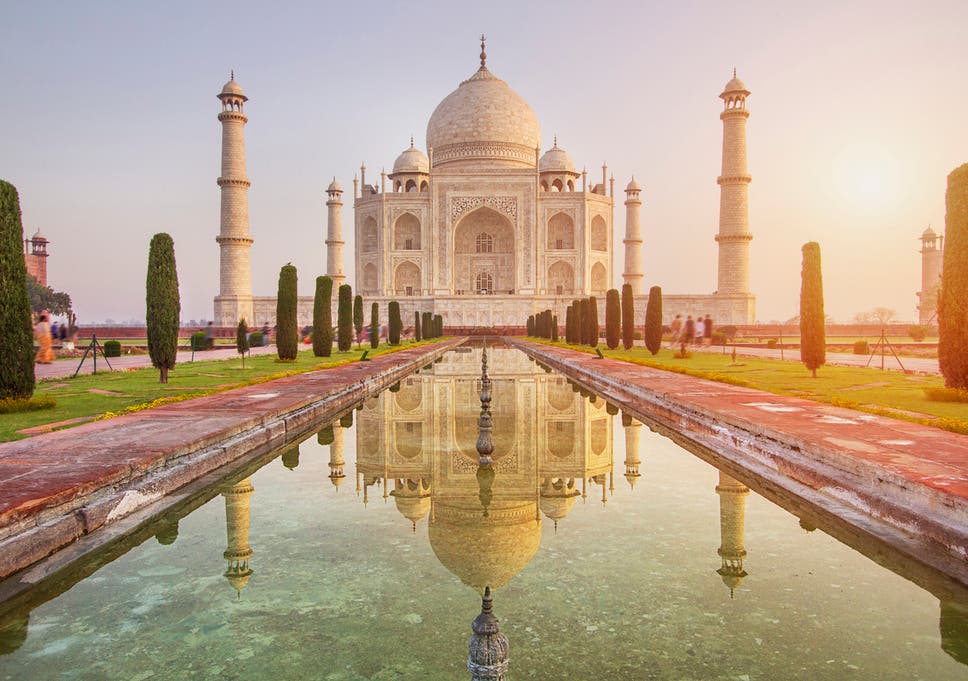
The Taj was built by Shah Jahan as a memorial to his third wife, Mumtaz Mahal, who died giving birth to their 14th child in 1631. The emperor was so heartbroken that his hair turned grey overnight. Construction started the next year and the whole complex was not finished till 1653. In total, 20,000 people from India and Central Asia worked on the building and artisans from Europe produced the exquisite marble screens and pietra dura (marble inlay work), made with thousands of semiprecious stones.
Declared a World Heritage Site in 1983, it went through a huge renovation in the early 20th century, and a thorough cleaning in 2002, so it looks just as immaculate today as when it was first constructed. Inside the massive sandstone gateways on the West, South, and East, the ornamental gardens are set out along classical Mughal lines – a square quartered by watercourses, with an ornamental marble plinth in the centre. When the fountains are not flowing, great reflections of the Taj show in the water.

The mausoleum itself stands on a raised marble platform with its back to the Yamuna River. Purely decorative 40m high white minarets grace each corner of the platform. They lean slightly out so they would fall away from the Taj in an earthquake. The central structure is made of semi-transluscent white marble, carved with flowers and inlaid in beautiful patterns. The four identical faces feature impressive vaulted arches embellished with pietra dura scroll work and quotations from the Quran using inlaid jasper.
The whole structure is topped off by four small domes surrounding the famous bulbous central dome. In the centre under the great dome is the cenotaph of Mumtaz and to the side that of Shah Jahan covered in fine pietra dura.

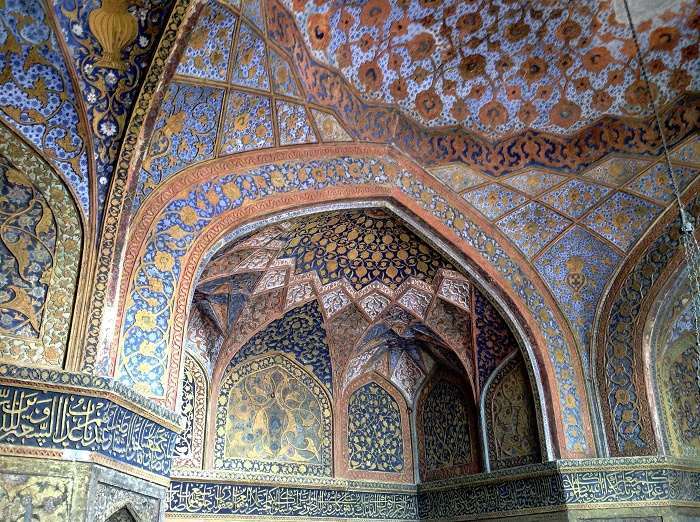
The false tombs (the real tombs are in a locked basement room below the main chamber and cannot be viewed) are surrounded by a ‘fence’ of exquisite perforated marble screens, each carved from a single piece of marble.

All the marble is covered in small inlaid flowers.

A red sandstone mosque is on the west side of the grounds, and an identical building to the east, the jawab, was built for symmetry. Mumtaz must have been quite the gal. The Taj Museum has some original paintings of the Shah and Mumtaz plus other artifacts. Not long after the Taj Mahal was finished, Shah Jahan was overthrown by his son, Aurangezh and imprisoned in Agra Fort, where he died 8 years later.

Agra Fort is one of finest Mughal forts in India. Construction of the massive sandstone fort was begun by Emperor Akbar (Shah Jahan’s grandfather), but Shah Jahan converted it into a palace. The colossal double walls, surrounded by a huge moat, rise over 20m in height and measure 2.5km in circumference. It contains a maze of buildings with halls, mosques, courtyards, a big throne, and palaces. The nicest building is the white marble octagonal tower where Shah Jahan was imprisoned. Most of the fort is actually used by the Indian Army and is off-limits.

Himad-ud-Daulah, or the Baby Taj, is the exquisite tomb of the Persian grandfather of Mumtaz, built from 1622-1629. It is more delicate than the Taj due to its finely carved Jali marble lattice screens. It was the first Mughal structure built entirely of marble, the first to make extensive use of pietra dura, and the first to be built on the Yamuna River. The outside is completely done in inlaid marble.

Chini-ka-Rauza is the Persian style riverside tomb of Shah Jahan’s chief minister. Bright blue tiles are crumbling from the outside of the mausoleum and the interior is painted in floral designs. On the river behind it, are big herds of water buffalo and a huge cow patty manufacturing site.
Mehtab Bagh is a park on the east bank of the river with gardens perfectly aligned with the Taj Mahal across the river. I went to see the last three sites on one rickshaw trip and the driver insisted that I go to the bazaar as he gets a commission on any sales (this happens all the time especially with hotels where rickshaw drivers almost refuse to take one to their hotel as they support ones that pay commissions or are owned by their uncle).
After two very hectic days, I am looking forward to the sleep on the train leaving at 11:20 to Khajuraho, the great kama sutra temple complex 7 hours, and 417km south-west of Agra.
MADHYA PRADESH STATE
Khajuraho (pop 20,000) has three groups of World Heritage listed temples, with some of the finest temple art in the world. Most of the 85 temples, of which 25 still remain, were built during a century long burst of creative genius from 950-1050 AD. Khajuraho’s isolation helped reserve it from the desecration Muslim invaders inflicted on ‘idolatrous’ temples elsewhere. The area was abandoned and fell into ruin with the jungle taking over until rediscovered by a British officer in 1838.

The temples are superb Indo-Aryan architecture, but it’s the liberally embellished carvings showing a storyboard of gods, goddesses, warriors, musicians, and real and mythological animals that have made it famous. Two elements appear repeatedly – women and sex. The pairs of men and women, usually depicted in erotic poses are carved with a half-twist and slight sideways lean that make the playful figures dance and swirl out from the stone. The most striking and best-preserved temples are in the Western Group. The Lakshmana Temple is a highly gymnastic orgy, including one gentleman proving that a horse can be a man’s best friend and a nine person orgy.
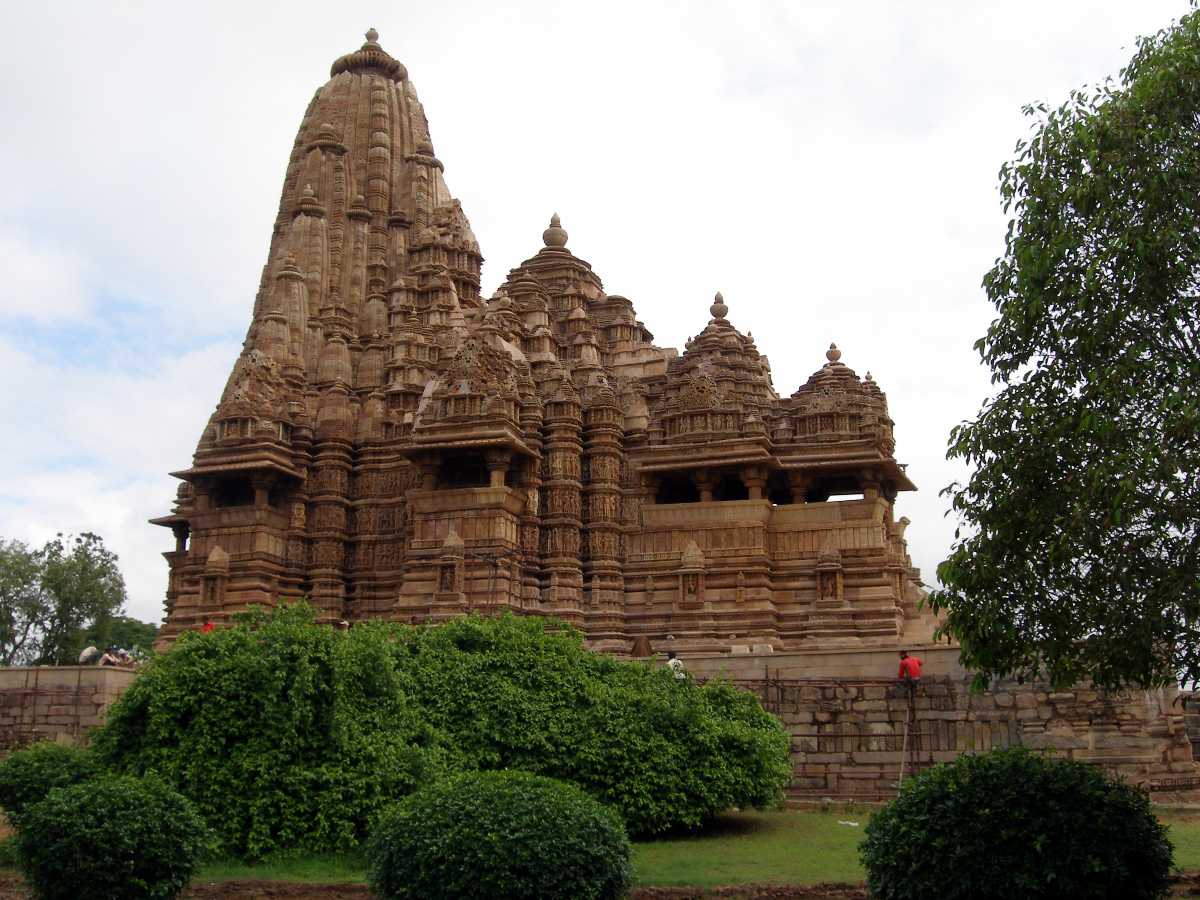
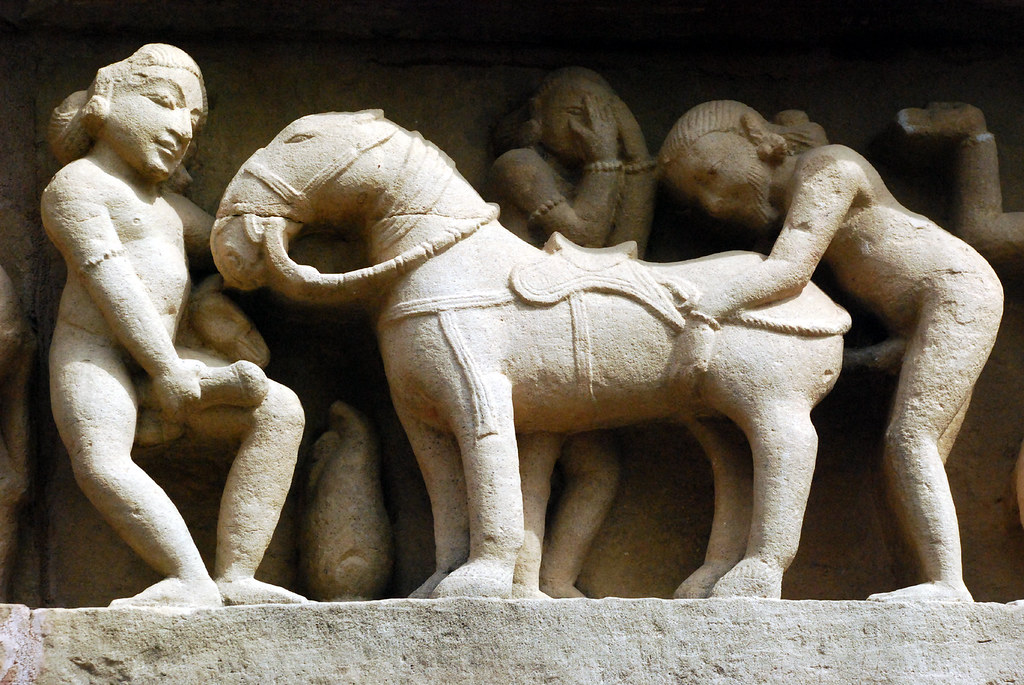

The 30.5m long Kandariya Mahadev with 872 acrobatic statues is the largest temple in town and represents the high point of Chandelan architecture. It also has the most representations of female beauty and sexual aerobics, all crammed into three central bands. One frequently photographed sculpture illustrates the feasibility of the handstand position.
Its 31m high tower, carved with geometric designs is, like linga, the phallic Shiva symbol, worshiped by Hindus hoping to seek deliverance from the cycle of reincarnation. 84 subsidiary spires produce a mountain-like roof reminiscent of the Himalayan abode of the gods. There are several other temples dedicated to Shiva, Vishnu, Parvati, Kali, and Durga. A 2.2m long statue of Nandi, Shivas bull vehicle, faces the Shiva temple. A festival is going on all over India today, and the town is packed. A temple (with a 2.5m long Shiva lingam) just outside the Western Group wall is a frenzy of Indian worshipers forming huge lines. The noise from the midway close to my hotel is almost deafening.
Some more observations about India. It must be the safest, in terms of robberies and assaults, of any country in the world for travellers. I have never heard of anyone being robbed in my 4 month experience. (however, just today I heard a report where a European woman with her husband was raped by 5 Indians). There are many reasons why personal crime may be so uncommon, even when there is crippling poverty. I initially thought that karma, the doing of good deeds, was central to the honesty, in order to be reincarnated up the line. Being a thief was sure to result in reincarnation as an animal. Especially bad is to come back as a dog. One hotel manager suggested that we are viewed as gods and Indians would never harm tourists. In ‘White Tiger’, on most travellers reading list, Indians also rarely rob other Indians, as dire repercussions would be extended to the thieves family. Travel is safe especially for the single woman traveler. Besides the occasional grope and lewd comments in Hindi, women are only at risk to being seduced by young men who use excessive flattery to wear them down. I have met several young western women who have been sexually active with Indians. Women also have the opportunity for more authentic interactions especially with Indian women, who are inaccessible to males outside their immediate families. Interest rates are high – 9.2% for long-term deposits and 10.2% mortgage rates.
Illiteracy is high – just 5 years ago 25% of men and 45% of women were illiterate which is very surprising given India’s reputation in education especially in IT. Elementary education has seen funding reduced. The Indian education system is highly criticized by foreigners as it involves primarily rote memorization and little critical thinking. Teachers dislike being questioned and teachers in the public system are notoriously poor. Many don’t even show up for work. This lack of critical thinking accounts for the fact that Indians are terrible as innovators. There has only been two Nobel laureates despite their enormous population and virtually nothing has been invented here. Job interviews when given by foreigners show their inability to think on their feet. When given a hypothetical situation and asked how they would respond to it, they are completely lost. Only 2% of Indians speak conversational English and they are concentrated in the biggest cities especially Delhi and IT centres like Bangalore. Knowledge of English creates a linguistic apartheid with only the upper classes knowing it well. The ability of most is little better than a few phrases with bad grammar and pronunciation.
The usual restaurant menu is rife with spelling errors. I have a terrible time being understood by Indians and need to repeat everything. I try to emulate an Indian accent but even salt or south are not understood.
Indians are great entrepreneurs and the small business – shop, sweet stand, street food stand, or tea shop – is the mainstay of 90% of the economy. Only 3% of the population works in organized corporations.
Corruption is rife in politics, the police, and throughout society and most Indians are tired of it. Bureaucracy is crippling. We see it in the huge amount of paperwork involved in a hotel registration.
The most common ads plastered everywhere are for educational opportunities and for cement. Stick built wood framed houses are unknown and everything is constructed with brick, cinder block, and cement reinforced with rebar. Never ask an Indian to find something on a map – they are hopeless.
Fire extinguishers are unknown. Stands with 4-6 red buckets holding sand and water are everywhere. Millions of brick latticework barricades protecting planted trees line every highway, but few contain living trees. Watering them seems to be the problem.
India is also the cheapest country in the world to travel in. With some effort, finding a $3 hotel room is easy. Eating on the street would cost only $2/day. Government buses and sleeper seats on trains allow travel for 30-50 cents an hour. All restaurants advertise an astonishing long menu including all types of veg and non veg Indian food along with Chinese, Italian, and continental cuisine. It is the easiest country anywhere to be a vegetarian in. Street food is invariably deep-fried. Chai shops are everywhere.
Everybody seems to get sick, either with bronchitis or vomiting and diarrhea. It seems that the people who are most fastidious get the most diarrhea. I am not very careful. I brush my teeth with tap water and don’t hand wash as often as I should. I’ve had only one self-limited episode of diarrhea in 4 months but had a terrible case of bronchitis requiring antibiotics.
Indians use a curious side to side ‘head wag’ that variously means ‘yes’, ‘no’, or ‘maybe so’. Vitiligo, an autoimmune skin disease that results in a symmetrical pigment loss is common and quite debilitating in dark-skinned people.
Some papers have huge matrimonial sections where both men and women advertise for spouses. They usually mention the father’s occupation, height, looks (all the men are handsome), skin colour (being light is good), career qualifications (many are now living in North America or Australia), and the importance of caste (the whole column is organized by caste). Light skin colour is valued in India and the sale of skin lighteners is big business. Most Bollywood stars are light-skinned and seem to be the only Indians who wear sun glasses. Chewing a lot of betel causes red teeth and Indians seem to be always using little packets of breath freshener. Tourism is down 25% since the gang rape in Delhi.
On my second day in Khajuraho, I walked out to the Eastern Group of temples to see the Jain temple complex. There is some exceptional carving and a guide pointed out the girl removing a thorn from her foot and the woman applying makeup using a mirror. Inside a dark temple, the fine carving showed a scorpion tattoo and saris clinging to ravishing female bodies. Many of the idols in these temples were standing (including a 4.5m Adinath) and displayed full male genitalia.
It was then a hot wait for my 18:20 twelve-hour train ride 604km to Delhi in Uttar Pradesh.
It was a much longer 15 hour train due to long delays – over an hour and a half to add cars at one stop and half an hour because of an accident on the tracks. I had my second episode of food poisoning from a pizza and woke up to vomit several times in the sink on the train. This reinforces my theory that restaurants are the usual sources of food poisoning, especially those that are not that busy and have slow food turn over. Arriving at 9 AM, I had about 27 hours to see the highlights of the capital city of India. I hired a taxi to go see the few sites in DELHI (pop 20 million) close to the Nizamuddin Train Station where most trains from the south arrive.
Humayun’s Tomb, a beautiful example of early Mughal architecture, was built in the mid-16th century. Built in a Persian style, the two-tone combination of red sandstone and white marble is entirely local. 12 hectares of formal gardens surround big gateways and domed mausoleums.The Obamas visited here on their visit to India.
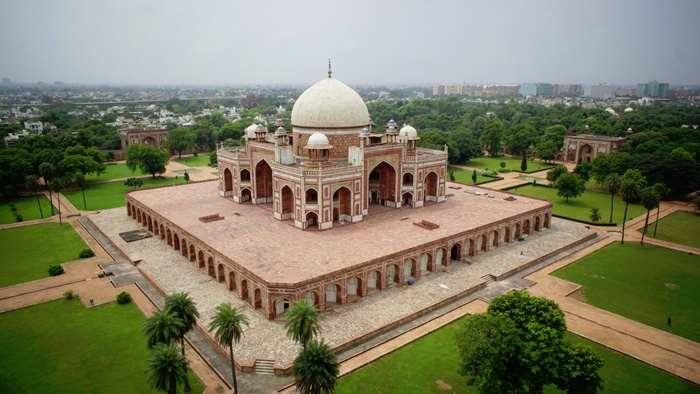

Hazrat Nizam-ud-din, amid a tangle of allies, is the vibrant marble shrine to the Muslim Sufi saint, Nizam-ud-din Christi. He died in 1325 and the mausoleum dates from 1562. The bright decorative painting and buzz around the site make it intriguing. The taxi drove though the wide boulevards of New Delhi. past India Gate (a 42 m high stone memorial arch that pays tribute to the 90,000 Indian army troops who died in WW I and the 1919 Anglo-Afghan war) and past all the government buildings to drop me off in the tourist ghetto of Paharganj at my hotel.
With time constraints, I took a tuk tuk to Jama Masjid, India’s largest mosque that can hold 25,000 people. This was Shah Jahan’s final architectural opus. Built between 1644-1658, it has 3 gateways, 4 single towers, and two 40 m high minarets built using alternating vertical strips of red sandstone and white marble.

I walked through the usual maze of streets of Old Delhi and along Chandi Chowk, a wide avenue thronged by crowds, hawkers and rickshaws, to the Red Fort. This massive sandstone fort’s 2km long wall is 18 m high on the waterfront and 33 m high on the city side. Built by Shah Jehan between 1638 and 1648, it has the usual assortment of moats, huge gates, Museums, great halls, baths, towers and mosques.
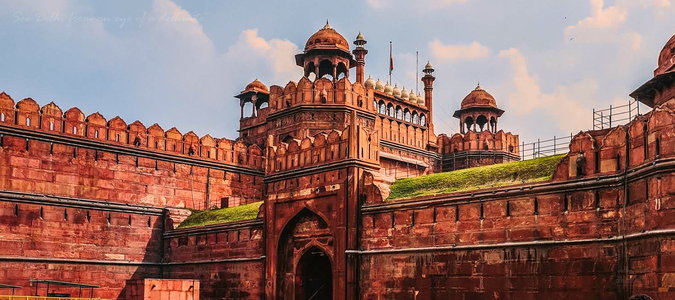
I then took the ultra-modern Metro south to Nehru Place, a shopping district, to buy a small lap top. Beware the Indian business man, I found an extra charge on my credit card, a pirated Windows program was installed, and many things were left off, including the ability to get wi-fi and other programs.
The next morning, I took the Metro to the far south of New Delhi to Qutb Minar, a complex of temples and towers that once formed the heart of the Muslim city.

![]()
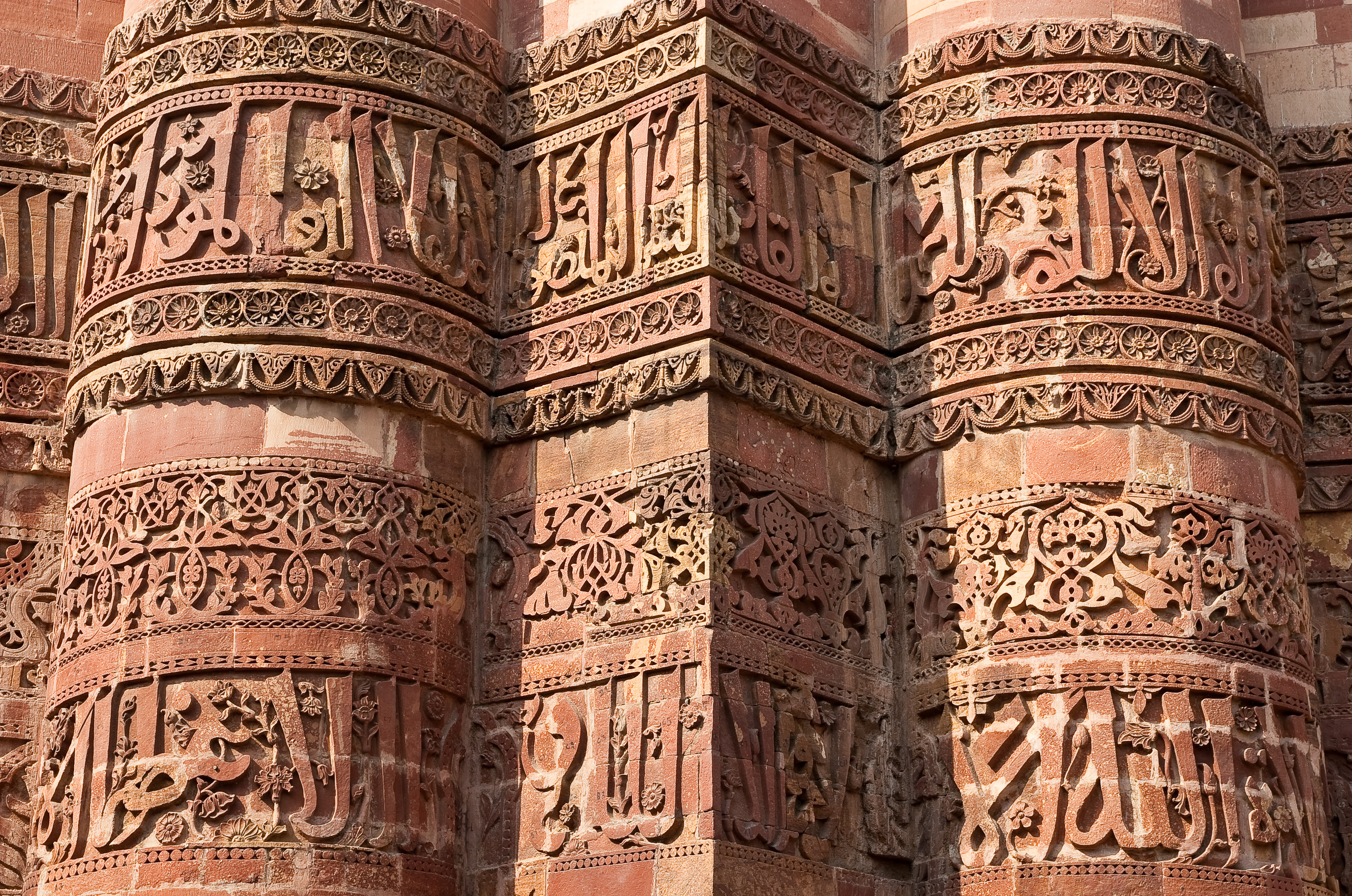
Qutb Minar is a mighty, awesome, 73 m high tower with a 15 m diameter base that tapers to 2.5 m at the top. It is a Unesco World Heritage Site. Construction was begun in 1193 and consists of five distinct stories, the first three of carved red sandstone, and the 4th and 5th of marble and sandstone, each with a projecting balcony. In 1326, it was struck by lightning and was rebuilt in 1326 and a cupola was added but the cupola was brought down by an earthquake in 1829. At the foot of Qutb Minar is the first mosque built in India in 1193. A 7 m high iron pillar stands in the courtyard of the mosque and was probably erected in about 400 AD. It is not understood how it was made as the iron is of such purity that it has not rusted in 2000 years. An unfinished tower planned on being twice as tall as Qutb Minar was started but never got past 27 m and is now a solid stack of rubble. The complex also has an exquisite gateway, a college, and an intricately carved tomb.
I rode the metro back to my hotel, showered, and caught the excellent train to Indira Ghandi International Airport to catch my flight to Sri Lanka. Good-bye India!